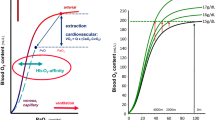Abstract
Bilirubinemia has been reported in man and animals exposed to high altitude, but the cause is not well known. Altered conjugation and delayed excretion of the pigment by the liver has been reported to contribute to the high serum bilirubin levels in man and animals exposed to high altitude, but the rate of development of bilirubinemia, the effects of severe polycythemia, altered erythrocyte fragility and intravascular hemolysis have not been thoroughly investigated. A study was made of the serum bilirubin concentration and the extent of intravascular hemolysis in rats during acclimatization to a simulated altitude of 5,500 m. During both continuous and intermittent (4h/d) exposure the serum bilirubin was significantly elevated at the end of 4 to 6 weeks. The elevations occurred only after severe polycythemia developed (hematocrit 68.5%, Hb 21.6 g/100 ml). An increase in intravascular hemolysis was found after 2 weeks intermittent exposure and after 4 weeks continuous exposure to 5,500 m. No change in erythrocyte fragility to account for increased intravascular hemolysis was found in any of the rats exposed continuously or intermittently to high altitude. No liver pathology was observed in rats exposed to 5,500 m. Bilirubinemia in the rat exposed to high altitude may have been due to the greatly increased erythrocyte number (hematocrit above 68%) and to a proportionate increase in destruction of erythrocytes, to increased intravascular hemolysis associated with the increased blood viscosity and possibly to an inability of the liver to handle increased levels of serum bilirubin.
Similar content being viewed by others
References
ALTLAND, P. D. and HIGHMAN, B. (1952): Effect of repeated acute exposures to high altitude on longevity of rats. Amer. J. Physiol., 168: 345–351.
ALTLAND, P. D. (1975): Tolerance of altitude-acclimatized rats to exercise in the cold. Proc. Soc. exp. Biol. Med. (N.Y.), 149: 656–660.
BACHER, R. P. and WILLIAMS, M. C. (1970): Hemolysis in capillary flow. J. Lab. clin. Med., 76: 485–496.
BARBASHOVA, Z. I. (1969): Dynamics of adaptive reactions at the cellular level during training of rats to hypoxia. Reviews of Research, Int. J. Biometeor., 13: 211–217.
BERENDSOHN, S. (1962): Hepatic function at high altitude. Arch. Int. Med. 109: 256–264.
BERNARDINI, A. T. (1969): Effect of reduced pressure and varied gaseous environment on the osmotic fragility of rat red blood cells. Fed. Proc., 28: 1165–1169.
BUNN, H. F. (1972): Erythrocyte destruction and hemoglobin catabolism. Seminar. Hematol., 9: 3–17.
FRYERS, G. R. and BERLIN, N. I. (1952): Mean red cell life of rats exposed to reduced barometric pressure. Amer. J. Physiol. 171: 465–470.
GARBY, L. and NOYES, W. D. (1959): Studies on hemoglobin metabolism. II Pathways of hemoglobin iron metabolism in normal man. J. clin. Invest., 38: 1479–1486.
GUYTON, A. C. and RICHARDSON, T. Q. (1961): Effect of hematocrit on venous return. Circ. Res., 9: 157–164.
HANKS, G. E., CASSEL, M., RAY, R. W. and CHAPIN, JR, H. (1960): Further modifications of the benzidine method for measurement of hemoglobin in plasma. J. Lab. clin. Med., 56: 486–498.
HENRY, R. J. (1964): Clinical Chemistry. Harper and Row, New York, p. 571, 602, 742.
HEPLER, O. E. (1949): Manual of clinical laboratory methods. Fourth Ed. C. C. Thomas, Springfield, Ill., p. 88.
HERSHKO, C. (1975): The fate of circulating hemoglobin. Brit. J. Haematol. 29: 199–204.
HURTADO, A. (1932): Studies at high altitude. Blood observations on Indian natives of the Peruvian Andes. Amer. J. Physiol., 100: 487–505.
HURTADO, A., MERINO, C. and DELGADO, E. (1945): Influence of anoxemia on the hemopoietic activity. Arch. Int. Med., 75: 284–323.
KEENE, W. R. and JANDL, J. H. (1965): The sites of hemoglobin catabolism. Blood, 26: 705–719.
LALLI, G. (1956): Comportomento della resistenza globulare nel dell' annosia cronica. Riv. Med. Aeronaut., 19: 638–643.
MALMEJAC, J., CRUCK, S. and NEVERRE, G. (1947): Sur l'hemolyse provoquée par la dépression barométrique. C.R. Soc. Biol. (Paris), 141: 392–395.
MERINO, C. F. (1950): Studies on blood formation and destruction in the polycythemia of high altitude. Blood, 5: 1–31.
MURRAY, J. F., GOLD, P. and JOHNSON, B. L. (1963): The circulatory effects of hematocrit variations in normovolemic and hypervolemic dogs. J. clin. Invest. 42: 1150–1159.
PIMSTONE, N. R. (1972): Renal degradation of hemoglobin. Seminar. Hematol., 9: 29–42.
RAMSØE, K., JARNUM, S., PRESIG, R., TAUBER, J., TYGSTRUP, N. and WESTERTAARD, H. (1970): Liver function and blood flow at high altitude. J. appl. Physiol., 28: 725–727.
REISSMANN, K. R., BURKHARDT, W. L. and HOELSCHER, B. (1952): Blood destruction in the polycythemia induced by hypoxia. Blood, 7: 337–349.
RICH, A. R. (1930): The pathogenesis of the forms of jaundice. Bull. Johns Hopk. Hosp., 9: 338–355.
SHOREY, J., SCHENKER, S. and COMBES, B. (1969): Effect of acute hypoxia on hepatic excretory function. Amer. J. Physiol. 216: 1441–1452.
SMITH, E. E. and CROWELL, J. W. (1967): Role of an increased hematocrit in altitude acclimatization. Aerospace Med., 38: 39–42.
STICKNEY, J. C., STEWART, P. S. and COLLINS, J. L. (1965): Plasma bilirubin and bromosulfophthalein clearance during simulated high altitude in unanesthetized rats. Proc. Soc. exp. Biol. Med. (N.Y.), 118: 433–435.
STICKNEY, J. C., NORTHUP, D. W. and VAN LIERE, E. J. (1943): Blood studies on dogs subjected to discontinuous exposure to low oxygen tension. Proc. Soc. exp. Biol. Med. (N.Y.), 54: 151–152.
SUNDSTROEM, E. S. and MICHAELS, G. (1942): The adrenal'cortex in adaptation to altitude, climate and cancer. Univ. California Press (Berkeley), 12: 1.
TRIPOD, J., La resistance globulaire à l'altitude chez le rat. Arch. int. Physiol., 55: 59–66.
VAN LIERE, E. J. and STICKNEY, J. C. (1963): Hypoxia. Univ. Chicago Press, Chicago, p. 185.
WILBRANDT, S. and HERRMANN, E. (1944): Die osmotische Resistenz der Erythrozyten im Hochgebirge. Helv. physiol. pharmacol. Acta., 12: 47–66.
Author information
Authors and Affiliations
Rights and permissions
About this article
Cite this article
Altland, P.D., Parker, M.G. Bilirubinemia and intravascular hemolysis during acclimatization to high altitude. Int J Biometeorol 21, 165–170 (1977). https://doi.org/10.1007/BF01553710
Received:
Issue Date:
DOI: https://doi.org/10.1007/BF01553710




